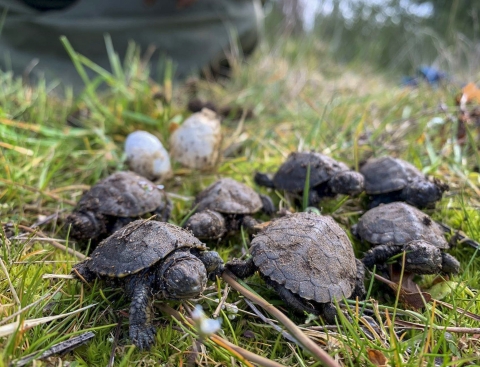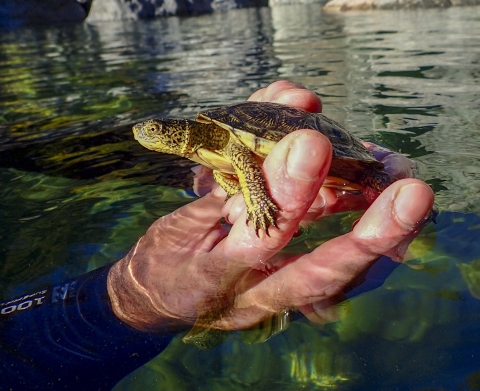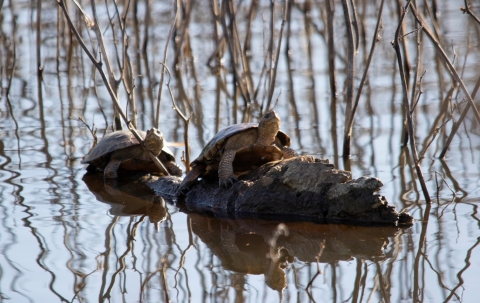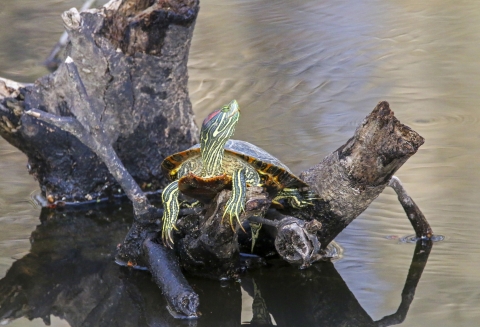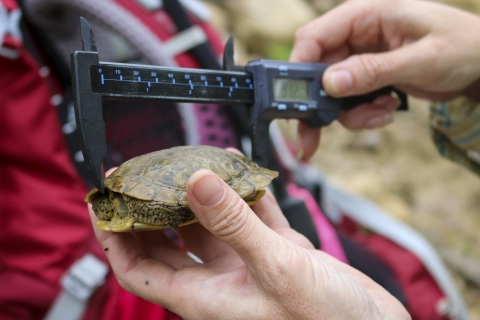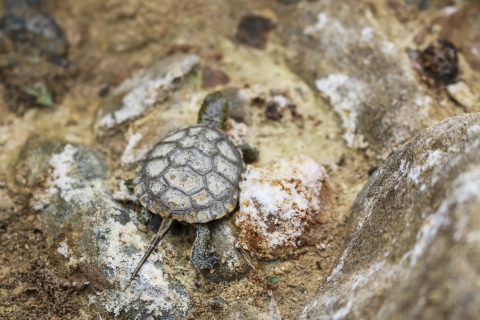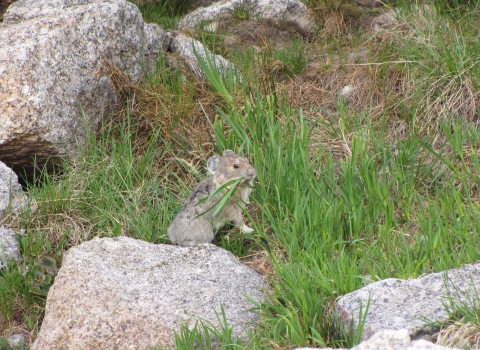By Ashley McConnell
Food, water and shelter for California’s only freshwater turtle are all becoming scarcer across the Western U.S. Wildlife experts say that worsening drought conditions, habitat loss and fragmentation, and invasive species invasive species
An invasive species is any plant or animal that has spread or been introduced into a new area where they are, or could, cause harm to the environment, economy, or human, animal, or plant health. Their unwelcome presence can destroy ecosystems and cost millions of dollars.
Learn more about invasive species could threaten the long-term survival of western pond turtles in the wild.
“Turtles, in general, are among the most imperiled vertebrates in the world,” said Cat Darst, assistant field supervisor with the U.S. Fish and Wildlife Service in Ventura, California.
That’s why federal, state and private partners across four western U.S. states and Mexico have developed a range-wide management strategy to help guide efforts to enhance, protect and restore habitat that is vital for western pond turtles in the future.
“Western pond turtles are a charismatic species that people get excited about,” said Jessie Bushell, Director of Conservation at San Francisco Zoo. “Kids love turtles. Adults love turtles. There is a lot of interest from across the range to protect this species, and many local organizations, in partnership with state and federal agencies, are working toward conserving and restoring important habitat to ensure long-term, sustained populations.”
Western pond turtles are made up of two distinct species, the southwestern pond turtle and northwestern pond turtle. They range from Puget Sound, Washington, in the north to northwestern Baja California, Mexico, in the south. There are also disjunct populations in far Western Nevada.
The strategy was developed by the Western Pond Turtle Rangewide Conservation Coalition, a comprehensive team of stakeholders with a shared vision of ensuring the long-term viability of western pond turtles in the wild.
The coalition is part of the Association of Zoos and Aquariums Saving Animals from Extinction initiative and includes representatives from the U.S. Fish and Wildlife Service, U.S. Forest Service, National Park Service, U.S. Geological Survey, Bureau of Land Management, Department of Defense, Washington Department of Fish and Wildlife, Oregon Department of Fish and Wildlife, Nevada Department of Wildlife, California Department of Fish and Wildlife, San Francisco Zoo, Oregon Zoo and Fauna del Noroeste A.C. in Baja California.
“The strategy is a blueprint for agencies and organizations across the West Coast to help western pond turtles when and where they need it the most,” Darst said.
Strategy recommendations include coordinated surveys, identification of priority conservation areas, threats management, outreach and education, and targeted research for recovery.
“People really care about turtles, and that bodes well for the long-term outlook,” Darst said. “I’m optimistic and amazed by the level of interest and collaboration, but I am concerned about the increasing level of threats.”
According to Darst, the coalition’s shared vision requires on-the-ground commitment and action by landowners and land managers across the landscape.
“With such a long-lived species, we still have time to help keep this turtle in much of its native range, but there are areas that will need more protections, more intervention and more monitoring to be sure that they don’t disappear,” said Bushell.
In December 2020, the U.S. Fish and Wildlife Service and Department of Defense formalized recommended best management practices for western pond turtles on military installations that own and manage thousands of acres of land across the West Coast.
These practices include, identifying and protecting nests during the breeding season, adding basking sites such as trees or logs, removing barriers such as fencing between ponds, streams and nesting habitats to allow for migration, and removing invasive predators such as bullfrogs, snapping turtles and non-native game fish. Here is a comprehensive list of recommended best management practices.
“While the BMPs were developed for military installations, they can be used by landowners and land managers across the pond turtle’s range,” said wildlife biologist Robert McMorran.
Western pond turtles require both aquatic and upland habitat throughout their life cycle. Although maximum lifespan is unknown, some western pond turtles live to be over 55 years old in the wild. Older adults, especially females, are critical for population stability.
“You might see these turtles basking in the sun on the shoreline, or on logs or rocks, in all types of aquatic habitats including creeks and ponds, but they tend to prefer areas away from human disturbance,” said McMorran.
The turtle pet trade presents an additional hurdle. Invasive red-eared sliders, native to the Eastern U.S., compete with native turtles for precious remaining resources and habitat. McMorran explained, “Commonly purchased as pets, when they are no longer wanted, pet owners often release them into nearby aquatic habitats where potential for introducing disease and increased competition may be detrimental to our native species, such as the pond turtle.”
In 2012, Center for Biological Diversity petitioned the U.S. Fish and Wildlife Service to list the western pond turtle under the Endangered Species Act. In 2015, the Service determined the listing may be warranted and is currently reviewing the species’ status based on the best available science. The status review is on target for completion in 2023.
“Turtles and other native aquatic species are indicators of healthy ecosystems and clean water,” Darst said. “When we start losing our native species, it’s an indication that our water systems are impaired, and that’s not good for people either.”
According to Bushell, the combined commitment and actions of the Western Pond Turtle Rangewide Conservation Coalition can get people on the ground and projects moving forward, especially in critical areas. “And I don’t think we are too late – we just need to keep moving forward,” she said.
If you own or manage land in Washington, California, Oregon, Nevada or Baja California, Mexico and would like to help western pond turtles, check out the resources below:
Western Pond Turtle Rangewide Management Strategy
Western Pond Turtle Recommended Best Management Practices on Military Installations


